2013 FORD SUPER DUTY ECU
[x] Cancel search: ECUPage 3 of 563

Locks 70
Locking and unlocking..................................70
SecuriCode™ keyless entry keypad.........................73
Security 75
SecuriLock® passive anti-theft system.......................75
Anti-theft alarm.......................................77
Steering Wheel 78
Adjusting the steering wheel..............................78
Steering wheel controls.................................78
Pedals 81
Adjustable pedals......................................81
Wipers and Washers 82
Windshield wipers.....................................82
Windshield washers....................................82
Lighting 83
Lighting control.......................................83
Autolamps...........................................84
Instrument lighting dimmer...............................85
Daytime running lamps..................................85
Front fog lamps.......................................86
Directionindicators ....................................86
Interior lamps........................................87
Windows and Mirrors 88
Power windows.......................................88
Exteriormirrors.......................................90
Interiormirrors .......................................92
Sunvisors ...........................................93
Moonroof............................................94
2Table of Contents
2013 F-250/350/450/550(f23)
Owners Guide gf, 1st Printing
USA(fus)
Page 17 of 563

Use of your Ford light truck as an ambulance, without the Ford
Ambulance Preparation Package voids the Ford New Vehicle Limited
Warranty and may void the Emissions Warranties. In addition, ambulance
usage without the preparation package could cause high underbody
temperatures, overpressurized fuel and a risk of spraying fuel which
could lead to fires.
If your vehicle is equipped with the Ford Ambulance Preparation
Package, it will be indicated on the Safety Compliance Certification
Label. The label is located on the driver’s side door pillar or on the rear
edge of the driver’s door. You can determine whether the ambulance
manufacturer followed Ford’s recommendations by directly contacting
that manufacturer. Ford Ambulance Preparation Package is only available
on certain Diesel engine equipped vehicles.
Using your vehicle as a stationary power source (PTO)
Refer to theDriving Hintschapter for more information and guidelines for
operating a vehicle equipped with an aftermarket power take-off system.
MOBILE COMMUNICATIONS EQUIPMENT
Using mobile communications equipment is becoming increasingly
important in the conduct of business and personal affairs. However, you
must not compromise your own or others’ safety when using such
equipment. Mobile communications can enhance personal safety and
security when appropriately used, particularly in emergency situations.
Safety must be paramount when using mobile communications
equipment to avoid negating these benefits.
Mobile communication equipment includes, but is not limited to, cellular
phones, pagers, portable email devices, text messaging devices and
portable two-way radios.
WARNING:Driving while distracted can result in loss of vehicle
control, accident and injury. Ford strongly recommends that you
use extreme caution when using any device or feature that may take
your focus off the road. Your primary responsibility is the safe operation
of your vehicle. We recommend against the use of any handheld device
while driving, encourage the use of voice operated systems when
possible and that you become aware of applicable state and local laws
that may affect use of electronic devices while driving.
16Introduction
2013 F-250/350/450/550(f23)
Owners Guide gf, 1st Printing
USA(fus)
Page 19 of 563
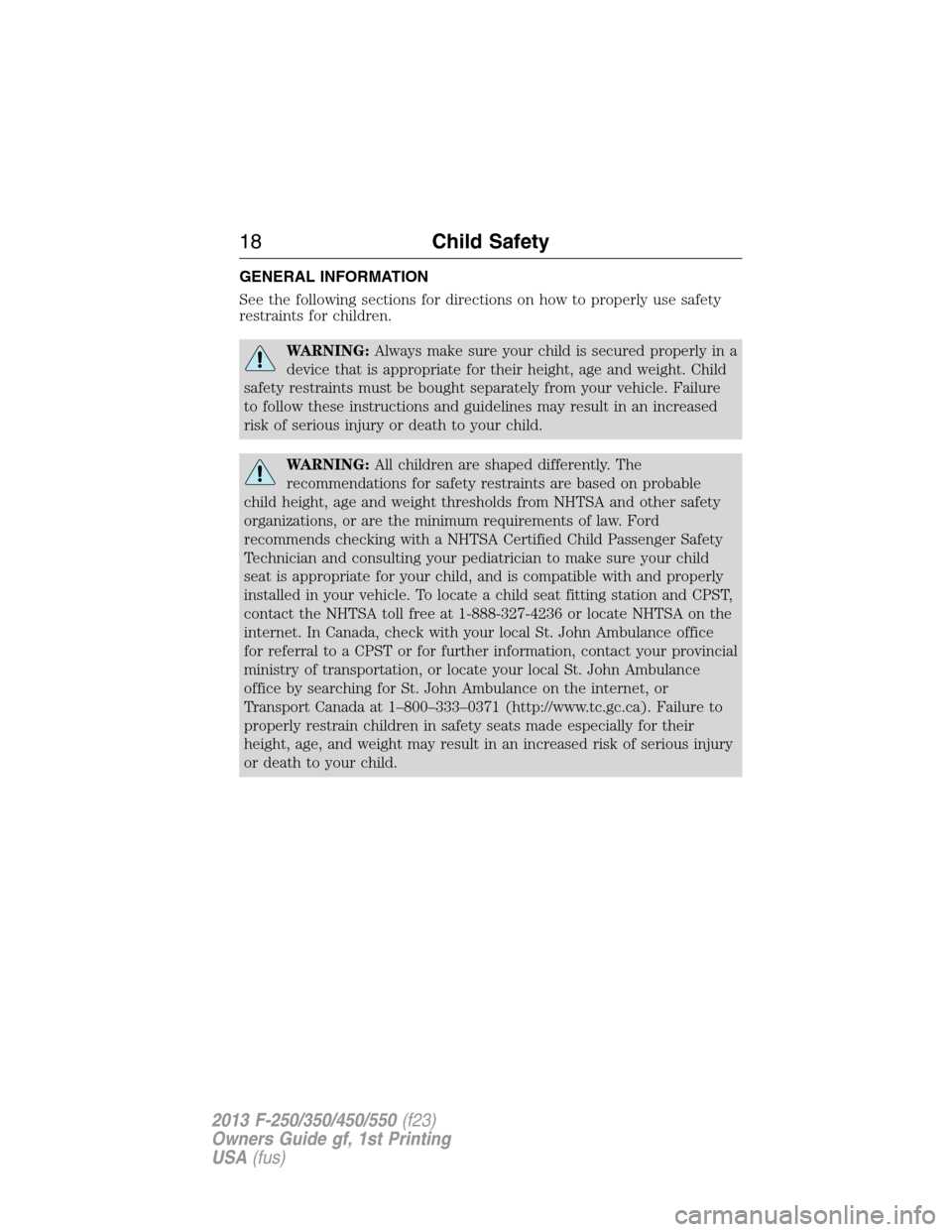
GENERAL INFORMATION
See the following sections for directions on how to properly use safety
restraints for children.
WARNING:Always make sure your child is secured properly in a
device that is appropriate for their height, age and weight. Child
safety restraints must be bought separately from your vehicle. Failure
to follow these instructions and guidelines may result in an increased
risk of serious injury or death to your child.
WARNING:All children are shaped differently. The
recommendations for safety restraints are based on probable
child height, age and weight thresholds from NHTSA and other safety
organizations, or are the minimum requirements of law. Ford
recommends checking with a NHTSA Certified Child Passenger Safety
Technician and consulting your pediatrician to make sure your child
seat is appropriate for your child, and is compatible with and properly
installed in your vehicle. To locate a child seat fitting station and CPST,
contact the NHTSA toll free at 1-888-327-4236 or locate NHTSA on the
internet. In Canada, check with your local St. John Ambulance office
for referral to a CPST or for further information, contact your provincial
ministry of transportation, or locate your local St. John Ambulance
office by searching for St. John Ambulance on the internet, or
Transport Canada at 1–800–333–0371 (http://www.tc.gc.ca). Failure to
properly restrain children in safety seats made especially for their
height, age, and weight may result in an increased risk of serious injury
or death to your child.
18Child Safety
2013 F-250/350/450/550(f23)
Owners Guide gf, 1st Printing
USA(fus)
Page 26 of 563
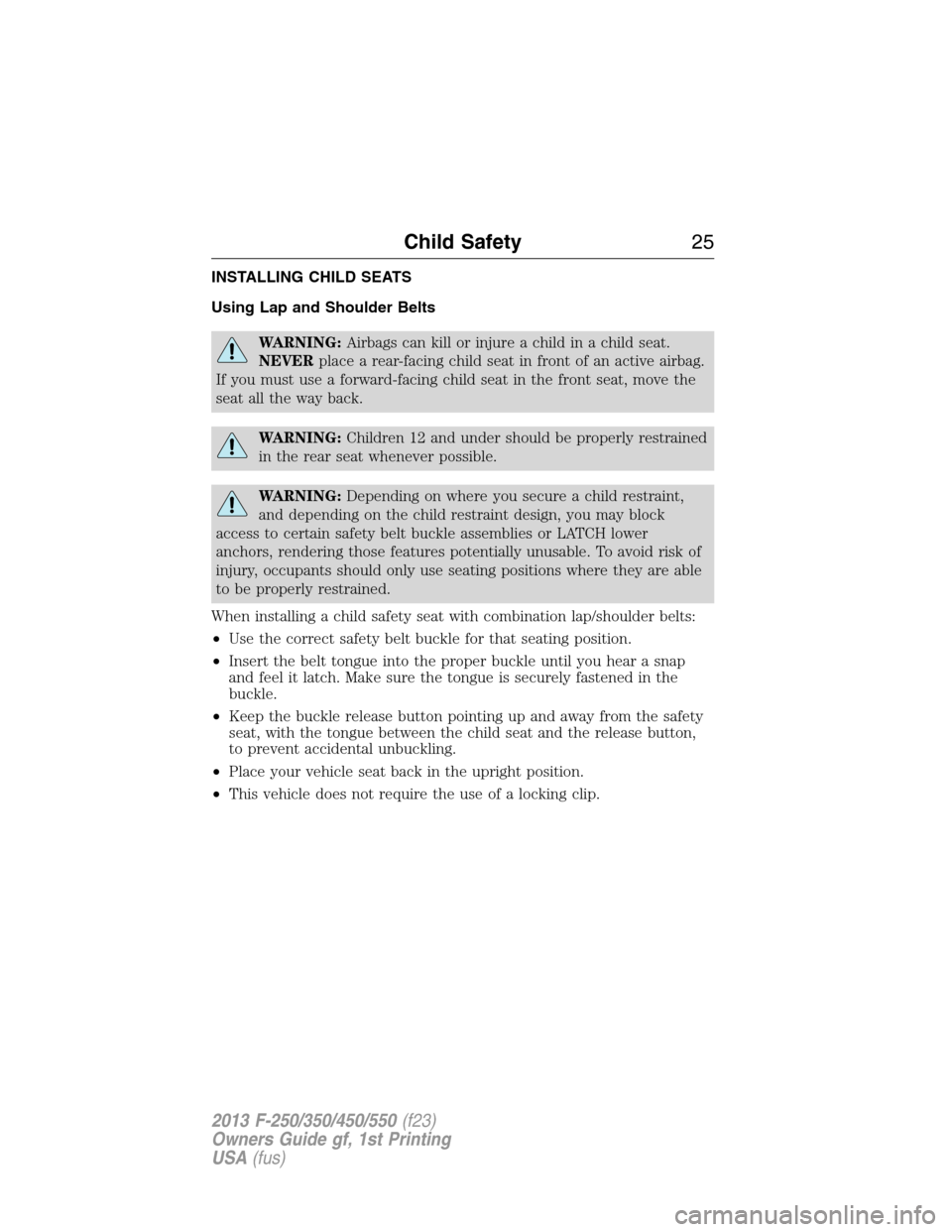
INSTALLING CHILD SEATS
Using Lap and Shoulder Belts
WARNING:Airbags can kill or injure a child in a child seat.
NEVERplace a rear-facing child seat in front of an active airbag.
If you must use a forward-facing child seat in the front seat, move the
seat all the way back.
WARNING:Children 12 and under should be properly restrained
in the rear seat whenever possible.
WARNING:Depending on where you secure a child restraint,
and depending on the child restraint design, you may block
access to certain safety belt buckle assemblies or LATCH lower
anchors, rendering those features potentially unusable. To avoid risk of
injury, occupants should only use seating positions where they are able
to be properly restrained.
When installing a child safety seat with combination lap/shoulder belts:
•Use the correct safety belt buckle for that seating position.
•Insert the belt tongue into the proper buckle until you hear a snap
and feel it latch. Make sure the tongue is securely fastened in the
buckle.
•Keep the buckle release button pointing up and away from the safety
seat, with the tongue between the child seat and the release button,
to prevent accidental unbuckling.
•Place your vehicle seat back in the upright position.
•This vehicle does not require the use of a locking clip.
Child Safety25
2013 F-250/350/450/550(f23)
Owners Guide gf, 1st Printing
USA(fus)
Page 28 of 563
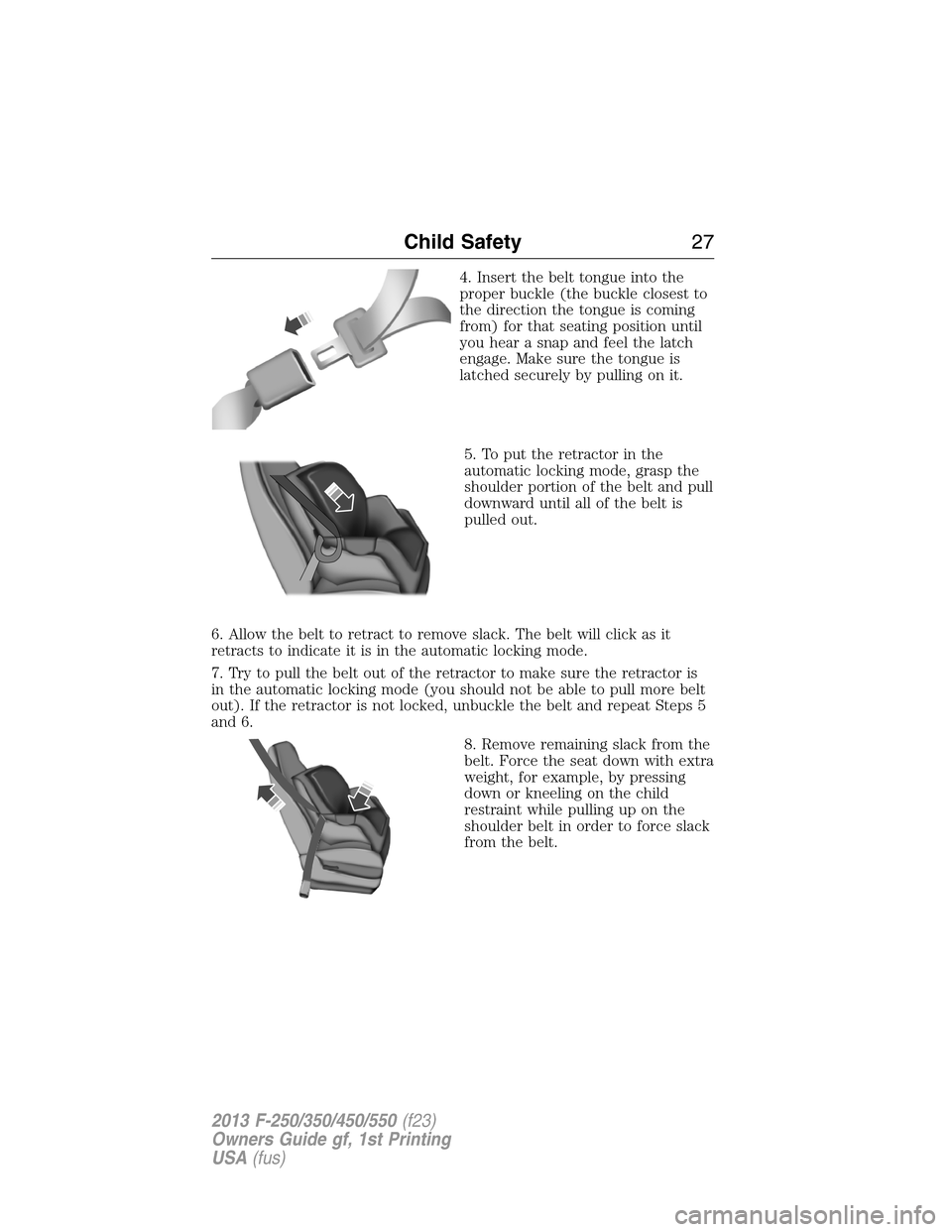
4. Insert the belt tongue into the
proper buckle (the buckle closest to
the direction the tongue is coming
from) for that seating position until
you hear a snap and feel the latch
engage. Make sure the tongue is
latched securely by pulling on it.
5. To put the retractor in the
automatic locking mode, grasp the
shoulder portion of the belt and pull
downward until all of the belt is
pulled out.
6. Allow the belt to retract to remove slack. The belt will click as it
retracts to indicate it is in the automatic locking mode.
7. Try to pull the belt out of the retractor to make sure the retractor is
in the automatic locking mode (you should not be able to pull more belt
out). If the retractor is not locked, unbuckle the belt and repeat Steps 5
and 6.
8. Remove remaining slack from the
belt. Force the seat down with extra
weight, for example, by pressing
down or kneeling on the child
restraint while pulling up on the
shoulder belt in order to force slack
from the belt.
Child Safety27
2013 F-250/350/450/550(f23)
Owners Guide gf, 1st Printing
USA(fus)
Page 29 of 563
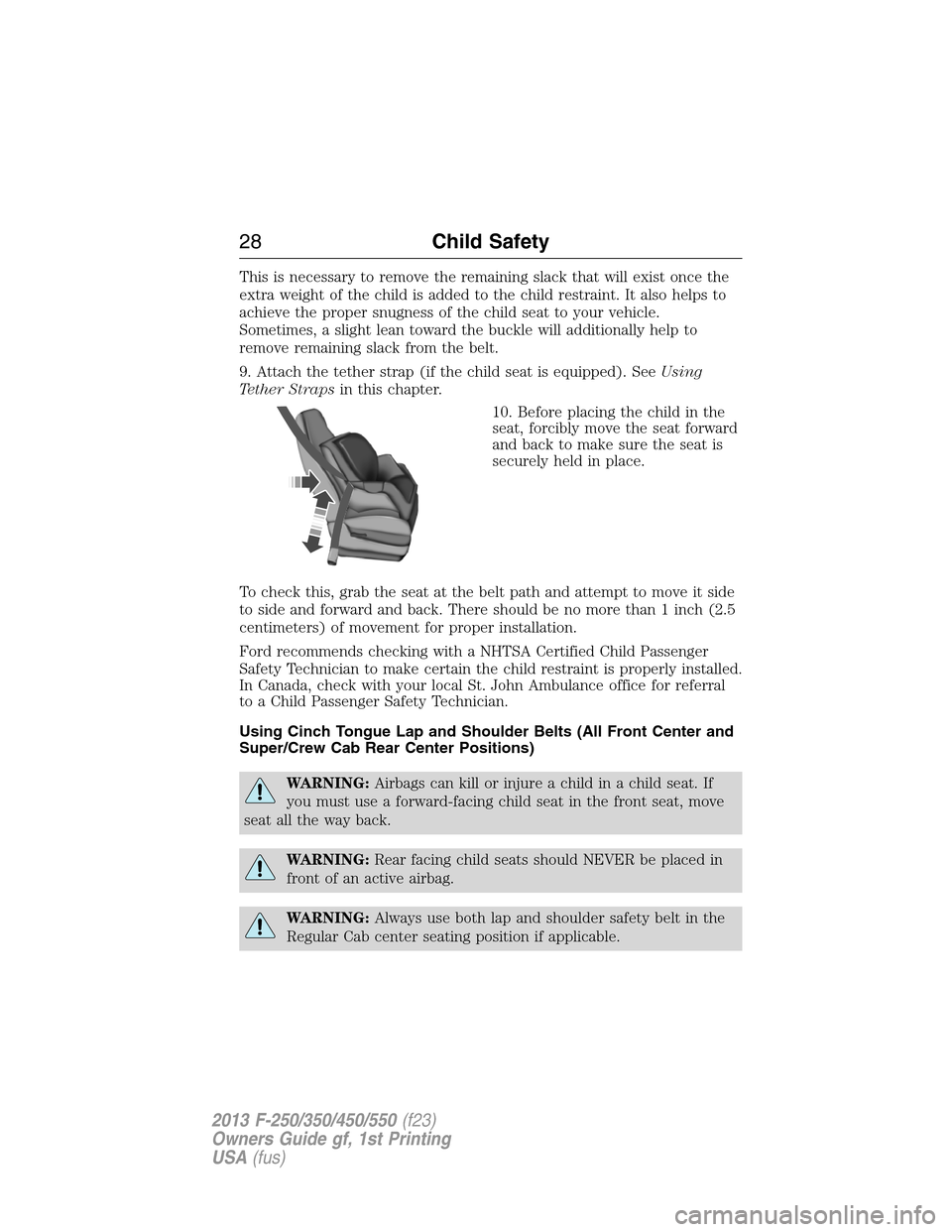
This is necessary to remove the remaining slack that will exist once the
extra weight of the child is added to the child restraint. It also helps to
achieve the proper snugness of the child seat to your vehicle.
Sometimes, a slight lean toward the buckle will additionally help to
remove remaining slack from the belt.
9. Attach the tether strap (if the child seat is equipped). SeeUsing
Tether Strapsin this chapter.
10. Before placing the child in the
seat, forcibly move the seat forward
and back to make sure the seat is
securely held in place.
To check this, grab the seat at the belt path and attempt to move it side
to side and forward and back. There should be no more than 1 inch (2.5
centimeters) of movement for proper installation.
Ford recommends checking with a NHTSA Certified Child Passenger
Safety Technician to make certain the child restraint is properly installed.
In Canada, check with your local St. John Ambulance office for referral
to a Child Passenger Safety Technician.
Using Cinch Tongue Lap and Shoulder Belts (All Front Center and
Super/Crew Cab Rear Center Positions)
WARNING:Airbags can kill or injure a child in a child seat. If
you must use a forward-facing child seat in the front seat, move
seat all the way back.
WARNING:Rear facing child seats should NEVER be placed in
front of an active airbag.
WARNING:Always use both lap and shoulder safety belt in the
Regular Cab center seating position if applicable.
28Child Safety
2013 F-250/350/450/550(f23)
Owners Guide gf, 1st Printing
USA(fus)
Page 31 of 563

4. Insert the belt tongue into the
proper buckle (the buckle closest to
the direction the tongue is coming
from) for that seating position until
you hear a snap and feel the latch
engage. Make sure the tongue is
latched securely by pulling on it.
5. While pushing down with your
knee on the child seat pull up on
the shoulder belt portion to tighten
the lap belt portion of the
combination lap and shoulder belt.
6. Allow the safety belt to retract and remove any slack in the belt to
securely tighten the child safety seat in the vehicle.
7. Attach the tether strap (if the child seat is equipped). SeeUsing
Tether Strapsin this chapter.
8. Before placing the child into the
child seat, forcibly pull the child
seat forward and back to make sure
that the seat is held securely in
place. To check this, grab the seat
at the belt path and attempt to
move it side to side and forward
and back. There should be no more
than 1 inch (2.5 centimeters) of
movement for proper installation.
30Child Safety
2013 F-250/350/450/550(f23)
Owners Guide gf, 1st Printing
USA(fus)
Page 32 of 563
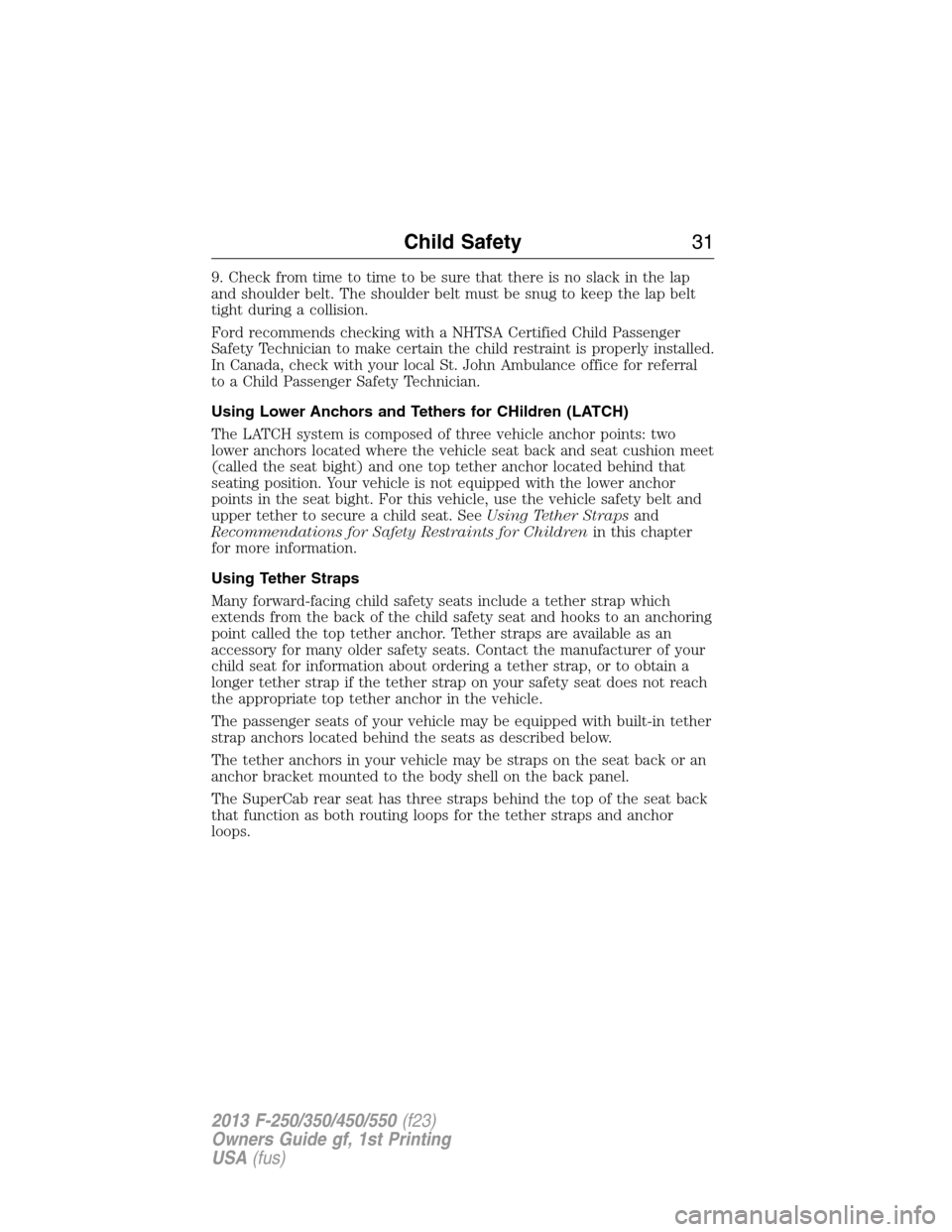
9. Check from time to time to be sure that there is no slack in the lap
and shoulder belt. The shoulder belt must be snug to keep the lap belt
tight during a collision.
Ford recommends checking with a NHTSA Certified Child Passenger
Safety Technician to make certain the child restraint is properly installed.
In Canada, check with your local St. John Ambulance office for referral
to a Child Passenger Safety Technician.
Using Lower Anchors and Tethers for CHildren (LATCH)
The LATCH system is composed of three vehicle anchor points: two
lower anchors located where the vehicle seat back and seat cushion meet
(called the seat bight) and one top tether anchor located behind that
seating position. Your vehicle is not equipped with the lower anchor
points in the seat bight. For this vehicle, use the vehicle safety belt and
upper tether to secure a child seat. SeeUsing Tether Strapsand
Recommendations for Safety Restraints for Childrenin this chapter
for more information.
Using Tether Straps
Many forward-facing child safety seats include a tether strap which
extends from the back of the child safety seat and hooks to an anchoring
point called the top tether anchor. Tether straps are available as an
accessory for many older safety seats. Contact the manufacturer of your
child seat for information about ordering a tether strap, or to obtain a
longer tether strap if the tether strap on your safety seat does not reach
the appropriate top tether anchor in the vehicle.
The passenger seats of your vehicle may be equipped with built-in tether
strap anchors located behind the seats as described below.
The tether anchors in your vehicle may be straps on the seat back or an
anchor bracket mounted to the body shell on the back panel.
The SuperCab rear seat has three straps behind the top of the seat back
that function as both routing loops for the tether straps and anchor
loops.
Child Safety31
2013 F-250/350/450/550(f23)
Owners Guide gf, 1st Printing
USA(fus)